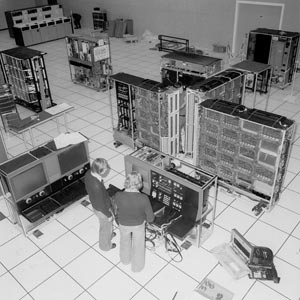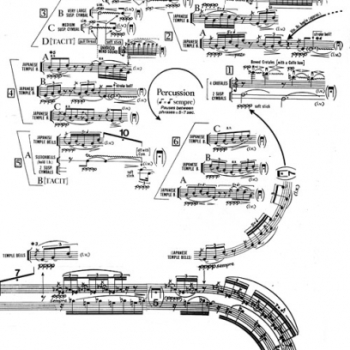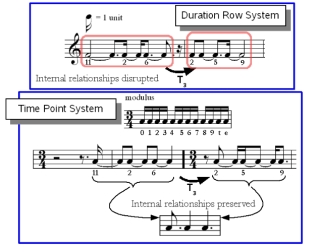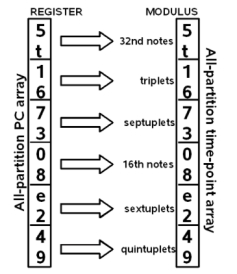Paul Lansky (1944- ) is a composer, teacher, and programmer. He recently retired as Professor of Music Composition at Princeton University. Lansky is/was a pioneer in the development of computer music languages for algorithmic compositions. He was a former student of Milton Babbitt and George Perle. Lansky studied at Princeton. In the early ‘70s, Lansky was drawn to electronic music, believing it “to be a way in which the properties of the 12-tone system could be more deeply investigated” (Cody 19)
Idle Chatter (1985) was the first of a 3 work set including: just_more_idle_chatter (1987), Notjustmoreidlechatter (1988)
The work was created on an IBM 3081 mainframe using punch cards and composed using linear predictive coding, granular synthesis and a variety of stochastic mixing techniques. It was written in a computer music language called Cmix. Idle Chatter was voiced by Hannah MacKay- Lansky’s wife. It was released on the album: More Than Idle Chatter in 1994.

“The six pieces on this disc all play with the music in speech. Some are content to chew on the garrulous sounds of people chattering away, while others, to varying degrees, worry about what the words actually mean. To my ear speech and song are not mutually exclusive: there is music in speech, and speech in song. These pieces are explorations along this terrain. In the end, I hope the listener comes away with a heightened sensitivity to the music of speech. If, on the other hand, what mainly emerges is a musically good and interesting time — well, that’s fine too.”- Paul Lansky
“The incoherent babble of Idle Chatter is really a pretext to create a complicated piece in which you think you can `parse the data’, but are constantly surprised and confused. The texture is designed to make it seem as if the words, rhythms and harmonies are understandable, but what results, I think, is a musical surface with a lot of places around which which your ear can dance while you vainly try to figure out what is going on. In the end I hope a good time is had by all (and that your ears learn to enjoy dancing).”- Paul Lansky
“I just isolate words, sort of flatten the pitch contours a bit, and then transpose them. The sustained stuff is done with granular synthesis.” Paul Lansky
Since there is only one recording, every single performance will be exactly the same. To remedy this, the work Lansky does involves a certain level of complexity that will, as mentioned earlier, hopefully baffle audiences upon first hearing. There are often many things going on and it’s frequently not clear what it is that you should let your ears follow. You have to make a conscious decision about how to listen and what to listen to. Lansky also thought it was crucial that the listener listen to the piece several times; this is essential for this work (Cope 156).
Lansky’s intention was also to make the listener into a performer, much in the same way that Cage intended for listeners to play an active role in his music, instead of being idle or passive bystanders (Cope 156). Lansky, also like Cage, wanted to eliminate compositional bias in his pieces; not in an aleatoric sense, but rather in a computational sense. Lansky decided that he wanted the software he uses to tell him as little as possible about how the music should go, and at the time, the only way to do this was to write his own software. He says his software deliberately has little intelligence and using it means investing more of his own intelligence into the music in the process (Cope 157).
Linear Predictive Coding based derivatives were pioneered by James Moorer at Stanford University in the 1970’s. A speech signal is produced by a buzzer at the end of a tube with occasional added hissing and popping sounds called sibilant (articulated consonants caused by the tongue directing a stream of air towards the sharp edge of the teeth) and plosive (a consonant produced by the stopping or all airflow to the vocal tract by blocking the vocal tract by the tongue, lips, or vocal folds) sounds. LPC works by analyzing the formants, removing their effects from the voiced sound or speech signal, and estimating the intensity and frequency of the remaining buzz. This process of removing the formants is called inverse filtering and the remaining signal after the subtraction of the filtered modeled signal is called the residue.
Lansky uses LPC to manipulate the voice recording of his wife, Hannah McKay, so that the frequency is modulated to a stable harmony, based on the pitch of “F.” He sustains this F for a long period of time, and eventually joins it by a D and a B-flat, making the harmony a simple B-flat major triad in 2nd inversion. This supposedly makes Idle Chatter Lansky’s first tonal piece. Lansky was originally going to base the piece off of that 12 tone tonality, but realized, mid-conception, that the B-flat major triad was all the piece needed, and decided not to push through chromaticism and serialism. In this aspect, the piece is extremely akin to the works of minimalist composers. (Novak)
Granular synthesis is a basic sound synthesis method that operates on the microsound time scale.It is based on the same principle as sampling. However, the samples are not played back conventionally, but are instead split into small pieces of around 1 to 50 ms. These small pieces are called grains. Multiple grains may be layered on top of each other, and may play at different speeds, phases, volume, and frequency, among other parameters. At low speeds of playback, the result is a kind of soundscape, often described as a cloud, that is manipulatable in a manner unlike that for natural sound sampling or other synthesis techniques. At high speeds, the result is heard as a note or notes of a novel timbre. By varying the waveform, envelope, duration, spatial position, and density of the grains, many different sounds can be produced.
Stochastic Mixing: In probability theory and related fields, a stochastic or random process is a mathematical object usually defined as a collection of random variables. Historically, the random variables were associated with or indexed by a set of numbers, usually viewed as points in time, giving the interpretation of a stochastic process representing numerical values of some system randomly changing over time, such as the growth of a bacterial population, an electrical current fluctuating due to thermal noise, or the movement of a gas molecule. Stochastic processes are widely used as mathematical models of systems and phenomena that appear to vary in a random manner.
Idle Chatter can be divided into two sections, an A section, and a B section. The entire A section presents a foreground layer- the steady babble of incoherent syllables, which is joined about a minute in by a background layer, a more melodic and considerably longer chorus of higher pitched vocals. The B section is a bit more complex, containing more recognizable tones that highlight certain phrases in the foreground of the babble, while the background chatter remains consistent throughout the entire piece (Ranta 1).
https://billiamn.wordpress.com
Cody, Joshua and Paul Lansky. “An Interview With Paul Lansky.” Computer Music Journal, Vol. 20, No. 1 (Spring 1996) The MIT Press. pp. 19-24 Lansky, Paul. More Than Idle Chatter
Cope, David. New Directions in Music. Prospect Heights: Waveland Press, Inc., 2001.
[compact disc liner notes] (1994) New York: Bridge Records Inc.http://paul.mycpanel.princeton.edu/liner_notes/morethanidlechatter.html
Ranta, Alan. “Idle Chatter About Paul Lansky.” PopMatters. 6 June 2011. 23 Sept. 2014 http://www.popmatters.com/column/141865-idle-chatter-about-paul-lanskys-notjustmoreidlechatter/P0/

 Theorists differ on which row is the un-transposed prime form, but it’s irrelevant because all the hexachords are derived from an all-combinatorial hexachord (0,1,2, 6, 7, 8).
Theorists differ on which row is the un-transposed prime form, but it’s irrelevant because all the hexachords are derived from an all-combinatorial hexachord (0,1,2, 6, 7, 8).
